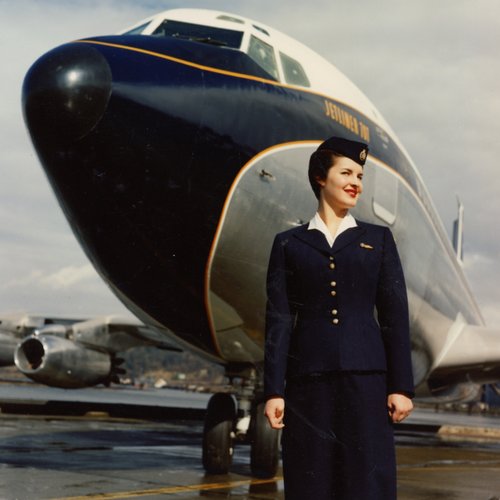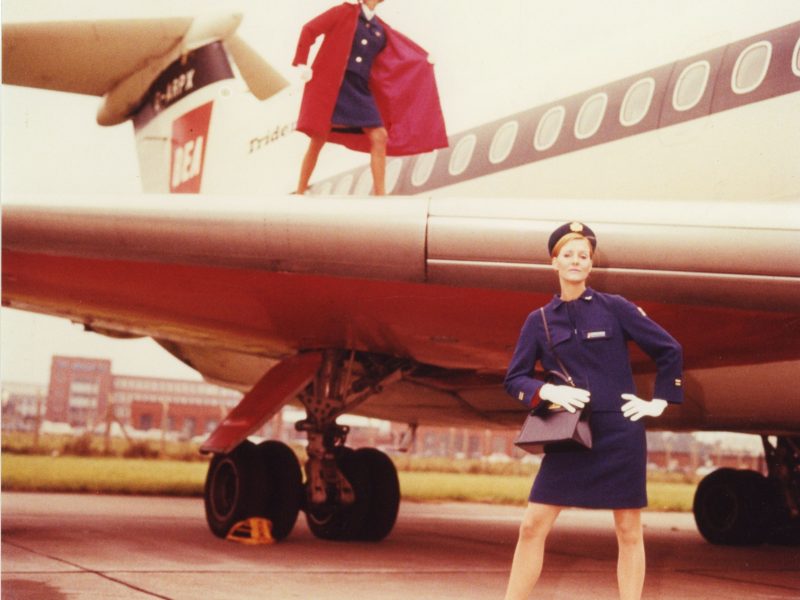Aerospace Bristol, home to the last Concorde to fly, is staging a fashion exhibition, showcasing iconic British Airways uniforms from the 1940s to today.
Since opening its doors in October 2017, Aerospace Bristol has welcomed hundreds of thousands of visitors, preserving the city’s rich aerospace heritage while inspiring the next generation of engineers. The museum continues to grow, with 2023 marking a record number of school visits and its highest visitor numbers to date.
This autumn, Aerospace Bristol turns its attention to fashion, with The Fashion of Flight, which showcases a variety of British Airways cabin crew and flight crew uniforms from the 1940s onwards. Among the highlights are some of the most outlandish pieces in history, including the BOAC paper dress designed for flights to the Caribbean and the entirely tartan uniform once used by Caledonian Airways.
The exhibition explores the evolution of airline uniforms, emphasising their impact on both fashion and aviation.
From the innovative paper dress to contemporary designs, the collection reveals how these uniforms reflect significant changes in history, culture and style.

Amy Seadon, head of collections, learning and interpretation at Aerospace Bristol, said: “Airline cabin crew have long been associated with first-class service and meticulously coiffured appearances. This exhibition highlights the shifts in societal norms through the decades and illustrates the transition from high fashion to practical functionality in cabin crew uniforms.
“We are incredibly grateful to British Airways for their support and look forward to welcoming everyone to experience the exhibition as part of a day out at Aerospace Bristol.”
Daphne Oldfield, a retired BOAC cabin crew member and Aerospace Bristol volunteer, says: “I remember my first uniform was a mini, just above the knee in raspberry pink with a zip up the front, with and a little sassy belt at the back that looked like a hairdressers’ overall.
“Just before that we had paper dresses for the Caribbean, which you cut to your preferred length. You can imagine some girls wanted it up high and got told off. Guys in the aisle would be trying to light your dress with a lighter. Those dresses didn’t last long.”
The Fashion of Flight is on until 17 November and is included with admission to Aerospace Bristol.
Street names honour the hidden heroes of Bristol’s aviation history
Two pioneering women in aviation and a former factory brass band leader are among the hidden community heroes who will have streets named after them at the second phase of new homes at Brabazon.
In the first phase of new homes Brabazon – the new neighbourhood for Bristol being built on the historic former Filton Airfield – the roads were named after some of the most celebrated figures from the airfield’s past.
The Heritage District is the next phase of new homes at Brabazon and lies at the historic heart of the former Airfield. To the west lies Hangar 16U; once a hive of activity maintaining aircraft, this historic Grade II listed building is currently being reborn as a local, social hub for the community. Immediately to the north is the Aerospace Bristol Museum, one of the best-loved visitor attractions in the region, and home to the last ever Concorde to fly.
When The Heritage District launches for sale, it is the unsung heroes of that pioneering age of aviation who will take centre stage. The new homes are set around six streets that will be named as follows:
Pedley Gardens: Elizabeth Pedley was an electronics engineer on Concorde and a trailblazing woman in aviation.
Sage Gardens: Named after Phyllis Audrey Ellen Sage, who worked in the print department at BAC during the 1940s.
Smart Street: Named after Ada Smart, who worked in the wing-making workshop during WWII.
Hawkins Close: Ed Hawkins was an unsung hero who worked on almost every major aircraft produced by BAC and Airbus for 43 years.
Watts Drive: Named after Brian Watts, the senior flight engineer on the maiden flight of Concorde in April 1969.
Yabsley Terrace: George Yabsley was the band leader of the BAC Works brass band in the 1940’s and a central figure in the local community as it shaped the era of modern air travel.
The hidden heroes were identified by an immersive community history project, led by local organisation The Natural Theatre Company, as well as from submissions to YTL Developments by residents.
David Sage, son of Phyllis, after whom Sage Gardens is named, said: “Brabazon is steeped in history. It was one of the biggest aircraft factories in the world. It was the birthplace of Concorde. Thousands of ordinary people came together to make that history happen. And during the Second World War my mother was one of them. It is such a thrill for our family to know that her contribution to her community is being recognised in this way.”
Andy Hawkins, son of Ed Hawkins and a current resident at Brabazon, said: “I was one of the first new residents at Brabazon. With the first phase of new homes now nearly complete, there is a really lovely feel to the neighbourhood. Much like in the Airfield’s aviation heyday there is a great community of people here.
“My father Ed worked here for 43 years, alongside pretty much most of my family and neighbours. Both parents were great examples of community builders in the road in Filton where I grew up. The fact that I now call this place home and there will be a street named after my father is really special and he would have absolutely loved it.”


